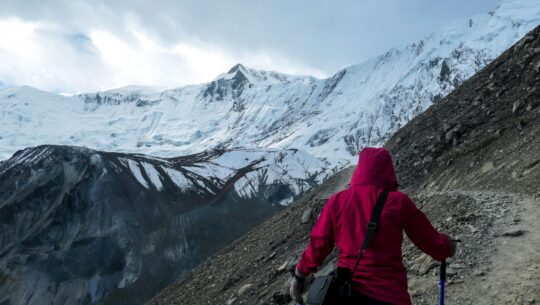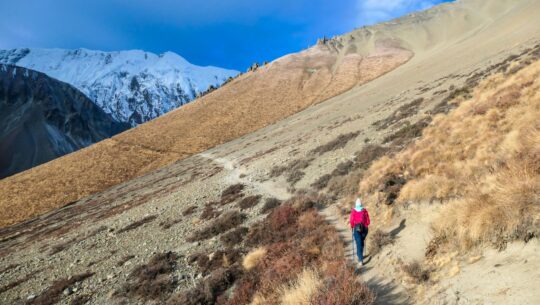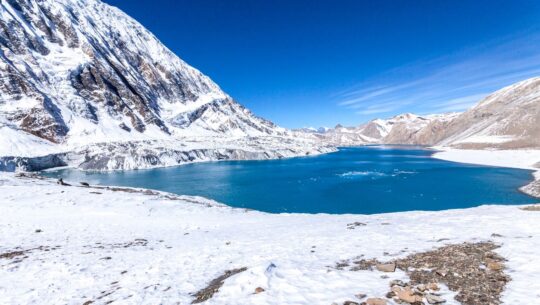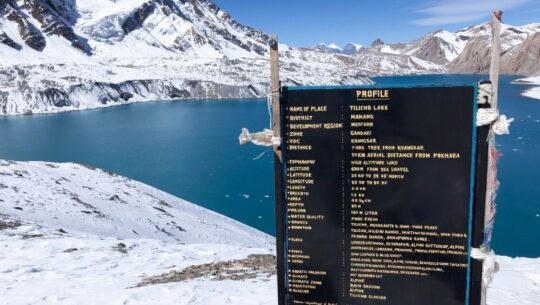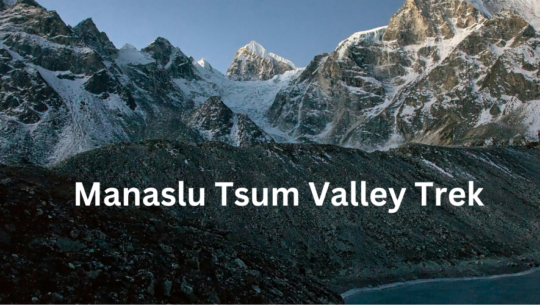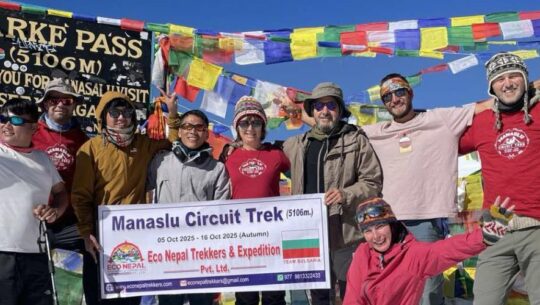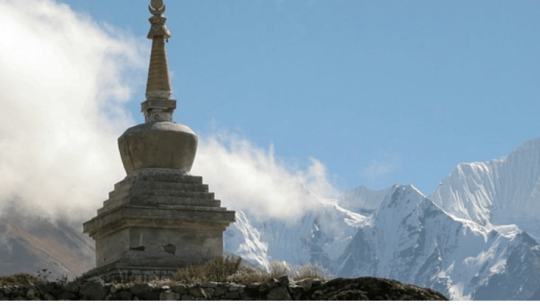Tilicho Lake Trek 7 Days
TripAdvisor Reviews Recommended by 99.99% travelers
USD 1050
Nepal
7 Days
Moderate to challenging
4,919 meters (16,138 feet) at Tilicho Lake
Teahouse lodges throughout the trek
Local Bus/private Jeep/Sharing Jeep
1-20
Feb, Mar, Apri, May, June, Sep, Oct, Nov & Dec.
- Tilicho Lake Trek takes you to the world’s second-highest accessible lake, offering a unique and awe-inspiring experience.
- The trek involves challenging terrain with minimal crowds, making it a less-traveled alternative to popular destinations like Annapurna Base Camp.
- Tilicho Lake Trek combines spiritual significance with scenic beauty, reflecting the region’s deep cultural ties to Hindu and Buddhist traditions.
- You’ll experience Tibetan-influenced culture and architecture in villages like Manang, which provides an experience ofthe Himalayan lifestyle.
- Tilicho Lake Trek offers breathtaking views of Annapurna II, Gangapurna, Tilicho Peak, and other Himalayan giants.
- During the trek, Safety is ensured by professional, licensed guides who monitor altitude sickness and manage emergencies.
- Tilicho Lake Trek includes a careful acclimatization process, with rest days and gradual elevation increases to ensure a safe ascent.
- At Tilicho Lake, you’ll witness stunning mirror-like reflections of surrounding peaks, creating an otherworldly and serene atmosphere.
- Tilicho Lake Trek features unforgettable sunrise views over the lake, with the best lighting for photography early in the morning.
- The trek provides rich cultural insights, with opportunities to explore ancient monasteries and villages while capturing stunning images of the landscapes.
Tilicho Lake Trek 7 Days Brief Insight
The 7-day Tilicho Lake Trek offers an awesome opportunity to see one of the world’s highest alpine lakes, Tilicho Lake, at 4,919 meters (16,138 feet).
Located in the Manang district of Nepal’s Annapurna range, Tilicho Lake measures 4 kilometers in length and 1.2 kilometers in width.
But here’s something that will blow your mind! Tilicho Lake is the longest high-altitude lake in the world.
In fact, for the longest time, it was also titled “the highest lake in the world”. However, that spot was recently taken by Kajin Sara at 5,200 meters.
However, standing at nearly 5000m, while enjoying the views of the world’s second-highest accessible lake and the highest Himalayas, is still awesome, right?
What Makes Tilicho Lake Famous?
The lake’s fame comes from multiple incredible factors.
Firstly, it creates mirror-like reflections of surrounding peaks. The color comes from glacial flour, which means finely ground rock particles suspended in water.
Second, reaching this lake requires significant effort through dramatic high-altitude terrain. This means, comparatively, there will be fewer crowds compared to other popular destinations like the Annapurna Base Camp Trek or the Nar Phu Valley Trek.
Third, the lake holds deep spiritual significance in both Hindu and Buddhist traditions.
According to Hindu scriptures, Tilicho Lake is the legendary Kak Bhusundi Lake mentioned in the Ramayana. As per the legends, the sage Kak Bhusundi narrated the epic to Garuda, the king of birds, at this very location.
As a matter of fact, Hindu pilgrims believe bathing in these waters brings spiritual purification, especially during full moon periods.
Why You Should Choose Our 7-Day Tilicho Lake Trek Package?
Our 7-day package offers optimal acclimatization while maximizing your mountain experience.
This carefully designed itinerary includes proper rest days in Manang for altitude adjustment. Furthermore, with us, you’ll get professional guide services throughout the journey.
These experienced individuals can navigate routes through landslide-prone areas. They monitor altitude sickness symptoms carefully.
Additionally, they will also offer cultural interpretation at monasteries and villages.
During times of need, they are trained to manage the emergency situation as well.
This balanced approach allows you to safely reach the world’s second-highest accessible lake.
Besides that, during the trek, our guide will introduce you to mountains like Annapurna II, Gangapurna, Tilicho Peak, and Nilgiri.
- Day 1: Kathmandu to Chame (2,670m) | 10 to 13 Hours Drive
- Day 2: Trek from Chame to Pisang
- Day 3: Trek from Pisang to Manang
- Day 4: Acclimatization Day in Manang (3,519m)
- Day 5: Trek Manang to Tilicho Base Camp (4,150m) | 5 to 7 Hours
- Day 6: Tilicho Lake Excursion and Return to Khangsar (4,919m)
- Day 7: Drive Khangsar to Kathmandu
Detailed Itinerary
Day 1: Kathmandu to Chame (2,670m) | 10 to 13 Hours Drive
Trek Distance :
238 km (148 miles)
Highest Altitude :
2,670m (8,759 ft at Chame Village)
Trek Duration :
10 to 13 hours drive
Meals :
Breakfast, lunch, and dinner included
Your adventure begins early morning when our guide picks you up from your Thamel hotel.
To reach Chame, you will have three transportation options:
Private Jeep Hire: The most comfortable option that accommodates up to 7 passengers with door-to-door service and flexible timing.
Shared Jeep Service: Budget-friendly option, but you’ll have to share the vehicle with other trekkers on scheduled departures.
Bus Plus Jeep Combination: The cheapest option, where we take a local bus from Kathmandu to Besisahar. Then catch a shared jeep from Besisahar to Chame. This option is particularly tiring compared to the other two, and it is also very time-consuming.
At max, the complete journey takes 10 to 13 hours, depending on road conditions and traffic.
From Kathmandu to Besisahar requires 6 to 7 hours via Prithvi Highway. The road passes through terraced agricultural fields and traditional Nepali villages.
You’ll drive alongside the Trishuli River initially, then follow the Marshyangdi River valley. First glimpses of the Annapurna range appear as you ascend toward Chame.
From Besisahar to Chame takes another 5 to 6 hours through increasingly challenging terrain. Four-wheel drive vehicles are mandatory for this section.
After arriving in Chame, the beautiful valley at an elevation of 2,670 meters, you will be welcomed at a local teahouse, where you will spend the night.
Day 2: Trek from Chame to Pisang
Trek Distance :
13.7 km (8.5 miles)
Highest Altitude :
3,200m (10,499 ft) at Pisang
Trek Duration :
5 to 6 Hours
Meals :
Breakfast/Lunch/Dinner
Your day starts early, but you get to enjoy breakfast with mountain views of Annapurna II and Lamjung Himal.
Right after breakfast, you’ll begin your journey to Pisang.
Today’s trek covers 13.7 kilometers (8.5 miles) with an elevation gain of 530 meters, and the difficulty level is going to be moderate.
The trail initially follows the Marshyangdi River through deep forests and walks through rhododendron and pine woodlands with fresh mountain air.
During the trek, you will first arrive at a small village named Talekhu (2,720m), from where you will reach Bhratang (2,850m).
After resting for a bit, the trail will lead you towards Dhikhur Pokhari (3,060m).
Then, you’ll cross suspension bridges over the rushing Marshyangdi River. The dramatic Paungda Danda rock face towers above the trail.
After 5 to 6 hours of trekking, the trail reaches Lower Pisang first at 3,200 meters. From there on, you can optionally climb to Upper Pisang at 3,300 meters for better views.
Both villages offer teahouse accommodations with basic rooms and shared bathrooms. Communal dining areas serve traditional dal bhat and international trekking menu items.
By the end of the day, you will be facing a total elevation gain of around 530 meters.
Day 3: Trek from Pisang to Manang
Trek Distance :
17 km (11 miles)
Highest Altitude :
3,519 m (11,545m) at Manang
Trek Duration :
5 to 6 hours
Meals :
Breakfast/Lunch/Dinner
Today will be the day when you get to experience the real Himalayan culture as you approach the famous Manang village.
The 5 to 6-hour trek covers approximately 17 kilometers with a gradual altitude gain of 319 meters.
Trail conditions transition from forested valleys to increasingly arid terrain.
Furthermore, you’ll be entering the rain shadow valley of the Annapurna range.
This means less rainfall and more desert-like conditions ahead, and vegetation becomes noticeably sparse.
However, today you’ll pass through the traditional Gurung villages of Ghyaru and Ngawal on the upper route.
These villages feature stone houses with flat roofs and colorful Buddhist prayer flags. The architecture reflects Tibetan influence.
Mountain views become spectacular! You’ll see Annapurna II (7,937m), Annapurna IV (7,525m), Gangapurna (7,455m), and Pisang Peak (6,091m).
Even though Manang sits at 3,519 meters, it offers the best accommodation variety on the entire trek.
For example, the well-rated Tilicho Hotel provides modern amenities, WiFi, and multiple dining areas. Other lodges offer similar facilities at competitive prices.
Meal options expand significantly here. You can enjoy fresh apple pies, Tibetan bread, and international cuisine. Traditional Nepali dishes remain the best choice for energy.
Day 4: Acclimatization Day in Manang (3,519m)
Trek Distance :
N/A
Highest Altitude :
3,519 m (11,545m) at Manang
Trek Duration :
2-3 hours for optional hike
Meals :
Breakfast/Lunch/Dinner
Today is a rest day.
This rest day is absolutely critical for your trek success. Let us explain why.
Proper acclimatization prevents altitude sickness by allowing your body to adjust to lower oxygen levels.
Your red blood cell production increases with time at altitude. Body chemistry gradually adapts to the thin air.
The golden rule is “climb high, sleep low.” You’ll take day hikes to higher elevations but return to sleep at Manang.
Nevertheless, you do have several excellent hiking options if you are looking to explore:
Gangapurna Lake and Glacier Viewpoint (3,900m): This 3 to 4-hour round trip offers stunning glacier views. The turquoise lake reflects the surrounding peaks beautifully.
Ice Lake or Kicho Tal (4,600m): Full-day hike with dramatic elevation gain. The reward is incredible turquoise lake views at high altitude.
Praken Gompa: Ancient monastery visit with mountain views of the entire Annapurna range.
Chongkor Viewpoint: Shorter 2-hour hike perfect for mountain photography without excessive exertion.
Suppose you don’t go for the optional hike. Then, visit Braga Gompa, a 600-year-old monastery that features intricate murals and statues. Buddhist monks still maintain daily prayer ceremonies here.
Besides that, you can also explore the Manang Culture Museum, which showcases traditional Nyeshang artifacts. Here, you’ll see traditional costumes, farming implements, and historical trading items.
To give you a better idea of Himalayan culture, our guides will help you interact with local Manangi people and learn about their unique Tibetan-influenced culture. Their trading traditions span centuries.
Here is the schedule that you might follow:
Start your acclimatization hike between 7 and 8 AM for the best weather conditions.
Return by early afternoon for rest and village exploration. Visit local facilities, internet cafes, and bakeries.
Evening activities include cultural experiences and early sleep to maintain acclimatization benefits.
Day 5: Trek Manang to Tilicho Base Camp (4,150m) | 5 to 7 Hours
Trek Distance :
11 km (6.8 miles)
Highest Altitude :
4,150m (14,796 ft) at Tilicho Base Camp
Trek Duration :
Drive 2-3 hours, then trek 3-4 hours
Meals :
Breakfast/Lunch/Dinner
Today represents the trek’s most demanding day. Mental and physical preparation is essential.
Your morning starts with a drive from Manang to Khangsar village (3,734m), which takes around 2 to 3 hours by jeep. The rough road follows the valley upstream.
Khangsar is known as “the last village of Nepal.” Traditional stone houses line narrow lanes. This settlement serves as the gateway to Tilicho Lake.
From Khangsar, you will trek 3 to 4 hours to Tilicho Base Camp with an elevation gain of 416 meters.
This section presents the trek’s most challenging terrain. Steep ascents cut through rocky moraine areas. Narrow trails follow exposed ridges.
In fact, the trail conditions deteriorate significantly above Khangsar. Loose scree slopes of the area require careful footing.
Altitude effects become more noticeable. You might experience headaches, shortness of breath, or mild nausea. These symptoms are normal but require monitoring. We advise you to contact a guide if you experience any of these symptoms.
As you reach your teahouse, expect basic conditions here. This is high-altitude mountain accommodation, not luxury lodging. But the mountain views make everything worthwhile!
Day 6: Tilicho Lake Excursion and Return to Khangsar (4,919m)
Trek Distance :
9 km (5.6 miles)
Highest Altitude :
4,919 m (16,139ft) at Khangsar
Trek Duration :
6-7 hours
Meals :
Breakfast/Lunch/Dinner
Today is the big day! You’ll finally reach Tilicho Lake at 4,919 meters in elevation.
You’ll wake up between 4:30 and 5:00 AM for pre-dawn preparation. Start hiking between 5:00 to 6:00 AM.
Early departure avoids afternoon weather deterioration. You’ll ensure adequate daylight for safe return. Morning also provides the best lighting conditions for photography.
Then, you will begin a 2 to 3-hour ascent that involves traversing unstable moraine slopes. Since there are many Potential snow fields, you need to navigate more carefully during this period.
Furthermore, in this region, the weather can change rapidly, with sudden fog, wind, or snow, which can dramatically reduce visibility within minutes.
Due to its demanding nature, it is essential to follow your guide’s instructions carefully.
But when you reach Tilicho Lake, it will all be worth it!
Standing at 4,919 meters, you’re at one of the world’s highest accessible lakes.
This glacial lake stretches 4 kilometers long by 1.2 kilometers wide. The Annapurna mountain peaks completely surround the water. Glacial melt feeds the lake entirely.
The lake often remains partially frozen even in warmer months. Ice formations create otherworldly beauty. The reflection of surrounding peaks in still water is unforgettable.
Take time to absorb this moment. Walk around the lake shore carefully. Capture photographs from different angles. Many trekkers describe this as a spiritual experience.
After spending 1 to 2 hours at the lake, begin your descent back to Khangsar.
The 3 to 4-hour descent allows for altitude recovery. Khangsar offers safer overnight accommodation with better facilities. Weather protection improves at lower elevations.
Sleeping at 3,734 meters instead of 4,150 meters significantly reduces altitude sickness risks.
Day 7: Drive Khangsar to Kathmandu
Trek Distance :
206 km
Highest Altitude :
4,919 m (16,139ft) at Khangsar
Trek Duration :
10 to 13 hours
Meals :
Breakfast included
Your final day involves the long journey back to Kathmandu.
Total travel time ranges from 10 to 13 hours with recommended stops for meals and rest.
Occasionally, we will stop in Besisahar and other roadside establishments for lunch and bathroom breaks.
The descending journey offers different perspectives of the Annapurna range. Marshyangdi valley terraced fields look different from this direction.
You’ll transition from high alpine zones back to subtropical elevations. The temperature gradually increases as you descend.
Arrival in Kathmandu
Arrive back in Kathmandu by late evening, typically between 7 to 9 PM.
Our guide drops you at your hotel in Thamel. Your incredible Tilicho Lake Trek adventure officially ends here.
As you settle back into city life, you’ll carry memories of alpine waters and towering Himalayan peaks.
Cost Includes
- Professional English-speaking licensed trekking guide
- All required permits (ACAP for Annapurna Conservation Area)
- Tourist Bus transportation from Kathmandu to Besishar and return
- Jeep Sharing Transport From Besisahar To Chame
- Teahouse accommodation throughout the trek
- Three meals daily during trekking (breakfast, lunch, dinner)
- Guide’s salary, food, accommodation, and insurance
- First aid kit and emergency oxygen cylinder
- Government taxes and service charges
- Pre-trek briefing and itinerary planning
- Permit acquisition assistance and documentation
- Basic trekking map of the region
- Achievement certificate upon completion
Cost Excludes
- International airfare to and from Nepal
- Nepal entry visa fees
- Lunch and dinner in Kathmandu
- Personal expenses (phone calls, laundry, bar bills)
- Travel insurance covering high-altitude trekking
- Porter service ($22 per day extra)
- Private room accommodation upgrade
- Hot showers and battery charging fees
- Tips for guide and driver (customary but optional)
- Helicopter evacuation in case of emergency
- Any activities not mentioned in the itinerary
Best Time for Tilicho Lake Trek
Timing makes all the difference for high-altitude treks, right? Let us break down the seasons.
Spring Season (March to May)
Spring offers perfect conditions for the Tilicho Lake Trek.
Daytime temperatures range from 10 to 20°C at lower elevations. Nighttime temperatures stay between 0 to 10°C. Minimal precipitation makes trails safe and dry.
Here’s what makes spring magical. Rhododendron forests bloom in spectacular displays of red, pink, and white colors. Nepal’s national flower creates natural beauty everywhere.
Weather patterns become increasingly stable as the season progresses. Some residual snow remains at the highest elevations, creating dramatic mountain scenery.
Autumn Season (September to November)
Autumn provides the second-best window, and many consider it optimal.
Daytime temperatures range from 8 to 16°C at trekking elevations. Nighttime temperatures drop to -5 to 5°C. Crystal-clear mountain views define this season.
Post-monsoon air clarity provides the most stable weather conditions annually. Your chances of seeing distant peaks like Mount Everest increase significantly.
Minimal precipitation means reliable trekking conditions. This is considered the best season for mountain photography.
Summer or Monsoon (June to August)
Summer temperatures are actually pleasant, ranging from 12 to 20°C during the day.
However, expect frequent rainfall below 3,000 meters. About 29 to 31 rainy days occur per month.
Monsoon brings increased landslide risks on roads and trails. Reduced visibility limits mountain views significantly. Trail conditions become challenging with mud and slippery rocks.
We generally don’t recommend this season for safety reasons. Only experienced trekkers should attempt monsoon treks.
Winter Season (December to February)
Winter transforms Tilicho into an extreme adventure destination.
Daytime temperatures range from 0 to 8°C at lower elevations. Nighttime temperatures plummet to -10 to -20°C at Tilicho Base Camp and the lake.
Significant snowfall occurs above 3,500 meters. Extreme cold creates hypothermia and frostbite risks. Limited teahouse operations make logistics challenging.
Only experienced winter trekkers with proper equipment should consider this season. Emergency evacuation becomes significantly more difficult.
Trek Difficulty and Fitness Requirements
How Difficult is the Tilicho Lake Trek?
The Tilicho Lake Trek rates as moderate to challenging on international trekking scales.
Primary difficulty factors include altitude reaching 4,919 meters. Daily trekking duration of 6 to 8 hours creates sustained exertion. Technical terrain includes loose scree slopes and narrow ridge traverses.
Physical Fitness Requirements
Cardiovascular Endurance: You need the ability to walk continuously for 6 to 8 hours. Carrying a 15 to 20 kg daypack at progressively higher altitudes requires stamina.
We recommend regular hiking, running, or cycling for 8 to 12 weeks before your trek.
Leg Strength: Strong quadriceps and calf muscles handle steep ascents and descents on rocky terrain. Stair climbing, lunges, and hill walking provide excellent preparation.
Core Stability: Balance and stability help navigate narrow trails and loose rock sections above 4,000 meters.
Training and Preparation Program
12 to 8 Weeks Before Trek:
Build basic cardiovascular fitness with 30 to 45 minute sessions. Exercise 4 to 5 times weekly with activities like jogging, cycling, or swimming.
8 to 4 Weeks Before Trek:
Increase intensity with hill walking and loaded pack training. Take longer duration exercises of 60 to 90 minutes. Include elevation gain in your training hikes.
4 to 1 Week Before Trek:
Maintain fitness level with reduced intensity. Prevent overtraining by allowing recovery. Focus on flexibility and stretching exercises.
Can Beginners Do This Trek?
Yes! Beginners with good physical fitness and proper preparation can successfully complete the trek.
Essential requirements include 8 to 12 weeks of cardiovascular training. Previous multi-day hiking experience is preferred but not mandatory.
Realistic expectations about challenges help significantly. Understand that altitude affects everyone differently.
Age Considerations
Recommended Age Range: 16 to 65 years with good health and fitness levels.
Younger Trekkers: Require guardian supervision and demonstrated hiking experience.
Older Trekkers: Should consult physicians beforehand. Consider additional acclimatization days for better adjustment.
Required Permits and Documentation
Good news! The permit process for the Tilicho Lake Trek is straightforward.
Annapurna Conservation Area Permit (ACAP)
This is the only permit required for the Tilicho Lake Trek.
Costs by Nationality:
- Foreign Nationals: NPR 3,000 ($25 USD)
- SAARC Nations: NPR 1,000 ($7 USD)
- Nepali Citizens: Free with proper ID
The permit includes 13% VAT and a 2.9% online payment gateway charge if processed online.
TIMS Card Status Update
Here’s something important. As of April 2023, TIMS cards are no longer mandatory for Annapurna region treks.
This simplifies the permit process significantly. You only need ACAP now.
Required Documents
Essential documentation includes a valid passport with a minimum of 6 months’ validity. Bring two passport-sized photographs for permit applications. Complete the application forms provided by your trekking agency.
Travel insurance policy covering high-altitude trekking up to 6,000 meters is strongly recommended. Emergency helicopter evacuation coverage is essential.
Where to Get Permits
In Kathmandu: Nepal Tourism Board Office at Bhrikutimandap. Tourist service centers in the Thamel area also process permits.
In Pokhara: Nepal Tourism Board regional office. Various trekking agencies can assist.
At Entry Points: Limited availability at Besisahar with potential additional fees.
Processing Time
Permits can be obtained up to 6 months before travel. No expiration date exists for single-use permits.
Same-day processing is available at major offices. Operating hours are 9:00 AM to 3:00 PM.
Online processing is available through the official NTNC portal with credit card payment.
Our package includes all permit acquisition assistance. Your guide handles the entire process for you!
Accommodation and Meals
What to Expect from Teahouse Lodges
Lower Elevations (Chame to Pisang) offer Modern teahouses that offer private rooms with basic furniture. Some have attached bathrooms with flush toilets. Hot showers are available for an extra fee ($2-5).
WiFi availability exists in most lodges, but you have to pay a bit extra.
Mid Elevations (Manang) offers the widest variety of accommodation here, thanks to road access. Upgraded lodges, such as Tilicho Hotel, offer heating and multiple dining areas.
Enhanced services include better mattresses and blankets. Some rooms have attached bathrooms with sit-down toilets.
High Altitudes (Tilicho Base Camp and Khangsar) offers Basic teahouse accommodation with shared facilities, which becomes standard. Limited heating uses yak dung or wood fires.
Expect simple rooms with basic bedding, and yes, there is an extra payment for all the basic amenities.
Above 4,000 meters, accommodation becomes increasingly basic. Shared bathrooms have squat toilets. Limited hot water availability exists.
Meal Options Throughout Trek
Standard Trekking Menu:
Dal bhat (rice and lentils with vegetables) provides the best trekking energy. Unlimited refills are customary with dal bhat orders.
Momos (steamed or fried dumplings) come with vegetable, chicken, or buffalo fillings.
Noodle soups (thukpa) warm you up on cold days. Fried rice and noodles provide quick energy.
Pancakes and porridge make good breakfast options.
Local Specialties:
Tibetan bread with jam or honey tastes amazing. Yak cheese adds flavor to various dishes. Churpi (dried yak cheese) makes excellent trail snacks.
Tsampa (barley flour) appears in traditional recipes. Butter tea represents authentic local culture.
International Options:
Pizza and pasta are available at lower elevations. Continental breakfast items exist in Manang. Options become limited above Manang.
Dietary Restrictions
Vegetarian Options: Excellent variety throughout the trek. Dal bhat is naturally vegetarian. Additional vegetable curries are always available.
Vegan Accommodations: Possible with advance communication to lodge owners. Dairy products are common in local cuisine, so specify your needs clearly.
Gluten-free Needs: Limited options require careful meal planning. Consider bringing supplementary foods.
Allergies: You need to tell us if you have any medical needs
Packing List For Tilicho Lake Trek
Clothing System
Base Layers:
Merino wool or synthetic moisture-wicking shirts (2-3 pieces). Thermal underwear for cold conditions. Non-cotton underwear and sports bras.
Insulation Layer:
Fleece jacket (Polartec 200 weight or equivalent). Lightweight down jacket rated to -10°C minimum. Warm trekking pants for cold evenings.
Outer Shell:
Waterproof breathable jacket with hood (Gore-Tex quality). Waterproof pants for weather protection.
Lower Body:
Hiking shorts for lower elevations. Convertible trekking pants for versatility. Thermal long underwear for high altitude.
Footwear Requirements
Primary Boots: Waterproof hiking boots with ankle support. Break them in completely before the trek. Make them compatible with gaiters.
Secondary Footwear: Lightweight camp shoes or sandals for lodge wear. Your feet need relief from boots.
Sock System: 4 to 5 pairs of moisture-wicking hiking socks. Thermal socks for cold conditions. Sock liners prevent blisters effectively.
Technical Equipment
Navigation and Safety:
Trekking poles (adjustable). Headlamp with extra batteries. Emergency whistle. Basic first aid kit.
Weather Protection:
Sunglasses with UV protection (Category 3 or 4). Sun hat and warm beanie. Neck gaiter or balaclava. Waterproof gloves plus liner gloves.
Sleeping System:
Sleeping bag rated to -10°C minimum (you can rent one in Kathmandu). Sleeping bag liner for hygiene and extra warmth.
Personal Items
Hygiene Essentials:
Quick-dry towel. Toothbrush and toothpaste. Biodegradable soap. Hand sanitizer. Wet wipes. Toilet paper with disposable bags.
Sun Protection:
High SPF sunscreen (30+ minimum). Lip balm with UV protection. After-sun lotion.
Personal Care:
Female hygiene products. Personal medications. Contact lens solutions, if applicable.
Medical Supplies
Altitude Medication:
Diamox (acetazolamide) with physician consultation. Basic pain relievers like ibuprofen. Anti-diarrheal medication.
Wound Care:
Antiseptic ointment. Bandages and gauze. Blister treatment patches. Medical tape.
Emergency Items:
Emergency blanket. Water purification tablets. Emergency food (energy bars). Cash for emergencies.
Rent or Buy?
Rent in Kathmandu:
Sleeping bags, down jackets, and trekking poles are available at $3 to $8 per day. Inspect rental gear quality thoroughly.
Purchase in Advance:
Boots, base layers, and personal clothing require proper fitting. Technical items need testing before the trek.
Safety Considerations During the Tilicho Lake Trek
Since altitude sickness (Acute Mountain Sickness or AMS) occurs when you ascend too rapidly above 2,500 meters, there is a risk of it from day 1 of this trek.
While the first three days possess minimal risk, days 4 and 5 possess a high risk.
During days 5 and 6, most of the trekkers cannot adjust properly to lower oxygen levels.
Which is why you need to contact guides when these symptoms arrive:
Mild AMS: Headache, mild nausea, fatigue, dizziness, difficulty sleeping, loss of appetite.
Moderate AMS: Severe headache, vomiting, increased fatigue, shortness of breath during exertion.
Severe AMS (HACE/HAPE): Confusion, loss of coordination, severe breathing difficulty, coughing pink foam. This requires immediate descent!
Prevention Strategies
Gradual Ascent: Follow the “climb high, sleep low” principle during acclimatization days. Limit sleeping elevation gains to 300 to 500 meters per day above 3,000 meters.
Proper Hydration: Consume 3 to 4 liters of water daily. Avoid alcohol and excessive caffeine. Monitor urine color for hydration status.
Nutrition: Maintain a high-carbohydrate diet (70% of calories). Eat regularly even without appetite. Avoid heavy meals that burden digestion.
Recommended Medications
Diamox (Acetazolamide): Take 125 to 250mg twice daily starting 1 to 2 days before ascent. Consult your physician for proper dosage and contraindications.
Ibuprofen: Provides headache relief and anti-inflammatory effects. Don’t mask serious symptoms, though.
Dexamethasone: Emergency medication for severe AMS. Requires medical supervision and evacuation planning.
What Kind Of Insurance Should You Have During This Trek?
High-Altitude Coverage: Ensure your policy covers trekking up to 6,000 meters in elevation. Helicopter evacuation costs range $5,000 to $15,000.
Medical Treatment: Coverage for treatment in Nepal is essential. Repatriation to the home country might be necessary.
Pre-existing Conditions: Declare all medical conditions honestly. Ensure coverage isn’t voided by adventure activities.
Cultural Insights During Tilicho Lake Trek
From the first day of the Tilicho Lake Trek, you’ll realize that Tibet heavily influences the culture.
Let us take Manang as an example. In Manang, every other house is built in Tibetan-style architecture with a flat-roofed stone.
Besides that, the major religion followed in this region is Buddhism, which is apparent from the numerous monasteries present in the region. The oldest one among them is the Braga Gompa of Manang, which is believed to be 600 years old.
Additionally, you can also enjoy the actual Himalayan lifestyle of the local Gurung settlement in the Khangra Village.
To gain more insights into the local culture of the region, you can visit the Manang Cultural Museum, which showcases the ancient Nyeshang Heritage.
Talking about their day-to-day life, their lifestyle includes a combination of barley cultivation during the season of barley and yak herding during the off-season.
Photography Locations During Tilicho Lake Trek
Now, after the heartfelt journey, you also might need a place where you can click some Instagram-worthy pictures.
Here are some of our recommendations:
- Tilicho Lake Sunrise: Offers a view of the mountains reflected in the crystal clear waters.
- Manang Valley: Wide-angle views that feature views of mountains like Annapurna II, Gangapurna, and Tilicho Peak.
- Braga Gompa Architecture: Offers traditional monastery photos with mountain backdrops.
Note: Take the photos 30 minutes before sunrise to get the instagram worthy photos.
Final Reasons For You To Convince On Tilicho Lake Trek Journey
The Tilicho Lake Trek is an unforgettable adventure, combining breathtaking mountain views, spiritual significance, and a chance to experience one of the world’s highest alpine lakes. It offers the perfect blend of challenge and reward, making it an excellent choice for both beginners and experienced trekkers. With a carefully designed itinerary for proper acclimatization, professional guides ensuring safety, and the beauty of the Annapurna region surrounding you, this trek promises to be an experience of a lifetime.
Note: This trek is short, and due to changing road conditions, the jeep from Besisahar to Khangshar might not be available at short notice. This means the days in the itinerary might get increased. So, we request our travellers to send us an enquiry before booking the trip.


